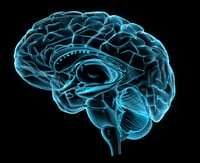Brain Activity Patterns After Trauma May Predict Long-Term Mental Health, Likelihood of Stress Disorders

How people’s brains respond to stress following a traumatic event may help to predict their long-term mental health outcomes, suggests a study published Thursday in AJP in Advance.
Jennifer Stevens, Ph.D., of Emory University and colleagues analyzed data from 69 participants in the AURORA study, a large-scale, multisite study funded by the National Institute of Mental Health that follows patients for a full year after exposure to trauma. The 69 patients in the current study received treatment in an emergency department following a car accident.
Two weeks after their accidents, the participants had their brain activity measured via functional MRI while they completed a series of standard computer-based tasks. The tasks assessed their brain activity in response to social threat cues, reward cues, and situations that required them to inhibit a response. Over the next six months, the participants also completed digital surveys in which they reported their mental health symptoms, including symptoms of posttraumatic stress disorder (PTSD), depression, dissociation, anxiety, and impulsivity.
Analyses of the participants’ brain activity data revealed the following four distinct profiles:
- Reactive/disinhibited: High reactivity related to both threat and reward, little activity related to response inhibition
- Low reward/high threat: High reactivity related to threat, low reactivity related to reward
- High reward: No reactivity related to threat, little activity related to response inhibition, and high reactivity related to reward
- Inhibited: Deactivation related to threat, some activity related to inhibition, and low reactivity related to reward
The researchers then performed the same analyses with another group of 77 AURORA participants who had received treatment following exposure to a range of traumatic events, including interpersonal trauma. In this group, they found evidence for three of the four profiles: reactive/disinhibited, low reward/high threat, and inhibited.
Looking at participants’ brain activity profiles in relation to their mental health outcomes, the researchers found that participants with the reactive/disinhibited profile—those who showed high reactivity to both threat and reward—reported higher levels of symptoms of both PTSD and anxiety over time compared with participants with the other profiles. However, the researchers found no association between any of the brain activity profiles and other mental health outcomes, such as symptoms of depression, dissociation, or impulsivity.
“Heightened reward reactivity in the early aftermath of a major stressor may be an underexplored risk mechanism for the development of stress-related disorders,” the researchers wrote. “The biotypes identified here … may provide important information about targeted interventions to address different forms of future stress-related psychopathology.”
For related information, see the American Journal of Psychiatry article “Individual Patterns of Abnormality in Resting-State Functional Connectivity Reveal Two Data-Driven PTSD Subgroups.”
Don't miss out! To learn about newly posted articles in Psychiatric News, please sign up here.






